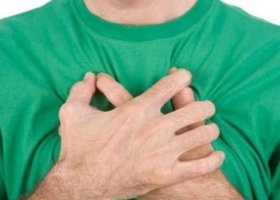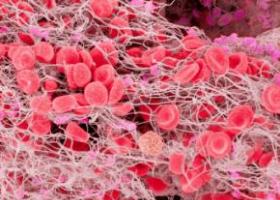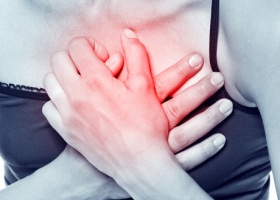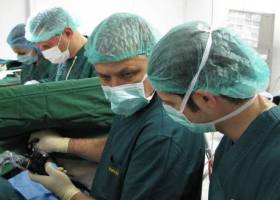June 15, 2012
- Flebodia, reviews hemorrhoids
- Hydrocephalus in children
- Campaign: a healthy heart!
- What are the medicinal properties of red wine have?
 Pulmonary embolism (a shortened version - PE) - a pathological condition in which blood clots rapidly clog branch pulmonary embolism . Blood clots in the veins occur initially systemic circulation rights.
Pulmonary embolism (a shortened version - PE) - a pathological condition in which blood clots rapidly clog branch pulmonary embolism . Blood clots in the veins occur initially systemic circulation rights.
To date, a very high percentage of people suffering from cardiovascular disease, it is due to die of pulmonary embolism. Quite often, PE causes of death of patients in the postoperative period. According to medical statistics, die about a fifth of all people with the manifestation of pulmonary thromboembolism. Thus fatal in most cases occurs within the first two hours after development of emboli.
Experts say that the incidence of pulmonary embolism is difficult to determine, since about half of the cases the disease goes unnoticed. Common symptoms are often similar to symptoms of other diseases, so diagnosis is often incorrect.
Causes of pulmonary thromboembolism
The most common pulmonary embolism occurs due to blood clots, originally appeared in the deep veins of the legs. Therefore, the main cause of pulmonary embolism is often the development thrombosis the deep veins of the legs. In more rare instances, thromboembolism trigger blood clots from veins of the right heart, abdomen, pelvis, upper limb. Very often, clots occur in those patients who, due to other ailments constantly comply with bed rest. Most often it is the people who suffer myocardial infarction . Lung Disease As well as those who received a spinal cord injury, underwent surgery on his hip. Significantly increased risk of thromboembolism in patients thrombophlebitis . It is often manifested pulmonary embolism as a complication of cardiovascular diseases: rheumatism . infective endocarditis . cardiomyopathy . hypertension . coronary heart disease .
However, pulmonary embolism, and sometimes strikes people without symptoms of chronic diseases. Typically, this happens when a person stays for a long time in a forced position, for example, often depart by plane.
To the human body formed thrombus, the following conditions: the presence of damage to the vascular wall, slow blood flow to the site of injury, high blood clotting.
Damage to the walls of the veins often occur in inflammation, in traumas and in intravenous injections. In turn, the flow of blood slows down due to the development of heart failure in a patient, by prolonged forced position (wearing a plaster bed rest).
The reasons for increased blood clotting doctors determine the number of violations of the hereditary nature, and such a state can trigger eating oral contraceptives , Disease AIDS . A higher risk of blood clots is determined in pregnant women, people with a second group of blood, and in patients obesity .
The most dangerous are blood clots that have one end attached to the vessel wall, and the free end of the thrombus is then in the vessel lumen. Sometimes it is just a small effort (person may cough, make a sudden movement, strain), and there is separation of the blood clot. Next, the bloodstream is the blood clot in the pulmonary artery. In some cases, clot hits the wall of the vessel and divided into small pieces. This may occur occlusion of small vessels in the lungs.
Symptoms of pulmonary thromboembolism
 Experts identify three types of PE, regardless of how much of the pulmonary vascular lesions observed. With massive pulmonary embolism more than 50% of affected lung vessels. In this case, the symptoms of thromboembolism expressed shock, a sharp fall Blood Pressure , Loss of consciousness, there is a lack of right ventricular function. The consequence of hypoxic brain with massive embolism are sometimes brain damage.
Experts identify three types of PE, regardless of how much of the pulmonary vascular lesions observed. With massive pulmonary embolism more than 50% of affected lung vessels. In this case, the symptoms of thromboembolism expressed shock, a sharp fall Blood Pressure , Loss of consciousness, there is a lack of right ventricular function. The consequence of hypoxic brain with massive embolism are sometimes brain damage.
Submassive thromboembolism determined in lesions from 30 to 50% of the vessels of the lungs. In this form of the disease a person suffers from shortness of breath But the blood pressure is normal. Violation of the functions of the right ventricle is less pronounced.
With nonmassive thromboembolism the function of the right ventricle is not broken, but the patient suffers from shortness of breath.
According to the severity of the disease is divided into thromboembolism acute . subacute and chronic relapsing . In the acute form of the disease begins PE sharply manifested hypotension, severe chest pain, shortness of breath. In the case of sub-acute thromboembolism occurs growth of right heart and respiratory failure symptoms infarcted pneumonia . Recurrent thromboembolism chronic form characterized by the repetition of shortness of breath, symptoms of pneumonia.
Symptoms thromboembolism directly dependent on how the process is massive, and the condition of blood vessels, heart and lungs of the patient. The main symptoms of pulmonary thromboembolism is a severe shortness of breath and hurried breathing . The manifestation of dyspnea is usually sharp. If the patient is in a recumbent position, it would become easier. The occurrence of shortness of breath - the first and most common symptom of pulmonary embolism. Shortness of breath shows the development of acute respiratory failure. It can be expressed in different ways: sometimes the man think he lacks a little air in some cases shortness of breath is particularly pronounced. Also featured is a strong thromboembolism tachycardia : Heart beats at a frequency of greater than 100 beats per minute.
In addition to dyspnea and tachycardia occur pain in the chest or a feeling some discomfort. Pain may be different. For most patients there was a sharp dagger chest pain. The pain may last for several minutes and several hours. If embolism develops the main trunk of the pulmonary artery, the pain can wear rending character and felt behind the breastbone. When massive embolism pain may spread to the sternum. Embolism small branches of the pulmonary artery can occur without any pain. In some cases, may occur Harkany blood, blue or paleness of the lips, ears, nose.
When listening to an expert reveals rales in the lungs, systolic murmur on the heart. During the echocardiogram revealed thrombi in the pulmonary arteries and the right heart, and there are signs of right ventricular function. On the X-ray visible changes in the lungs of the patient.
As a result of occlusion decreased pumping function of the right ventricle, resulting in the left ventricle receives enough blood. It is fraught with reduction of blood in the aorta and arteries, which provokes a sharp drop in blood pressure and shock. Under such conditions, the patient develops myocardial infarction . atelectasis .
Often the patient is an increase in body temperature to subfebrile, sometimes febrile indicators. This is due to the fact that the blood is thrown many biologically active substances. Fever It may last from two days to two weeks. A few days after pulmonary thromboembolism some people may have pain in the chest, coughing, Harkany blood, symptoms of pneumonia.
Diagnosis of pulmonary embolism
 In the process of diagnostics performed a physical examination of the patient to identify specific clinical syndromes. The doctor can determine wheezing, hypotension, determines the body temperature, which rises in the early hours of the development of PE.
In the process of diagnostics performed a physical examination of the patient to identify specific clinical syndromes. The doctor can determine wheezing, hypotension, determines the body temperature, which rises in the early hours of the development of PE.
The main methods of examination in thromboembolism should include carrying out an electrocardiogram, chest radiography, echocardiography, biochemical blood.
It should be noted that approximately 20% of cases of thromboembolism can not be determined with the help of the ECG, as no changes are observed. There are a number of specific features, determined in the course of these investigations.
The most informative method of analysis is considered ventilation-perfusion lung scan. It carries out research by angiography.
In the process of diagnosing thromboembolism also shown holding a tool inspection, during which the doctor determines whether phlebothrombosis lower extremities. To detect venous thrombosis applied radiopaque venography. Carrying an ultrasonic Doppler blood vessels of legs reveals patency of veins.
Treatment of pulmonary embolism
Treatment thromboembolism directed primarily to activate perfusion lung . Also, the goal of therapy is to prevent symptoms postembolic chronic pulmonary hypertension .
If there was a suspicion on the development of PE, step prior to hospitalization, it is important to immediately ensure patient adherence to strict bed rest. This will prevent the recurrence of thromboembolism.
Manufactured CVC for infusion therapy, and careful monitoring of central venous pressure. If there is acute respiratory failure, the patient produce tracheal intubation . To reduce severe pain and relieve the pulmonary circulation, the patient must take opioids (for this purpose is preferably used a 1% solution Morphine ). This drug is also effective in reducing dyspnea.
Patients who have an acute right ventricular failure, shock, hypotension, intravenous reopoligljukin . However, this drug is contraindicated in high central venous pressure.
In order to reduce the pressure in the pulmonary circulation is assigned intravenous eufillina . If the systolic blood pressure less than 100 mm Hg. Art., this medication is not used. If the patient diagnosed with pneumonia infarction, it is prescribed therapy antibiotics .
To restore the patency of the pulmonary artery, is used as a conservative and surgical therapy.
Methods of conservative therapy include the implementation and maintenance of thrombolysis thrombosis prophylaxis for the prevention of re-embolism. Therefore, thrombolytic treatment is performed for the rapid restoration of blood flow through the occluded pulmonary arteries.
Such treatment is carried out in the case, if the doctor is confident in the accuracy of diagnosis and can provide a complete laboratory control of the process of therapy. Be sure to take into account a number of contraindications for use of this treatment. These are the first ten days after surgery or injury, presence of concomitant diseases, in which there is a risk of hemorrhagic complications, the active form TB . hemorrhagic diathesis . esophageal varices .
 If there are no contraindications, treatment Heparin begin immediately after having been diagnosed. Doses should be adjusted individually. Therapy continues appointment anticoagulants . The preparation warfarin patients shown to take at least three months.
If there are no contraindications, treatment Heparin begin immediately after having been diagnosed. Doses should be adjusted individually. Therapy continues appointment anticoagulants . The preparation warfarin patients shown to take at least three months.
People who have clear contraindications to thrombolytic therapy, removes the clot surgically (thrombectomy). Also, in some cases, the installation of suitable cava filters in the vessel. This mesh filters that can trap blood clots come off and do not allow them to get into the pulmonary artery. Such filters are inserted through the skin - mainly through the internal jugular or femoral vein. Install them in the renal veins.
Prevention of pulmonary embolism
For the prevention of thromboembolism is important to know what kind of conditions predispose to the appearance of venous thrombosis and thromboembolism. Especially pay attention to their own state must be people who suffer from chronic heart failure, forced a long time to comply with bed rest, are massive diuretic therapy for a long time taking hormonal contraceptives. Furthermore, the risk factor is a number of systemic connective tissue diseases and systemic vasculitis . diabetes . The risk of thromboembolism increases with stroke , Spinal cord injury, prolonged catheter in the central vein, the presence of cancer and chemotherapy. Pay particular attention to their own health should be taken for those who have been diagnosed Varicose veins of the legs , Obese people suffering from cancer. Therefore, to avoid the development of pulmonary embolism important time to leave the state of postoperative bed rest, to treat leg veins thrombophlebitis. People who are at risk, it is shown LMWH prophylaxis.
To prevent symptoms of thromboembolism periodically receiving relevant antiplatelet agents : There may be a small dose acetylsalicylic acid .
No comments:
Post a Comment